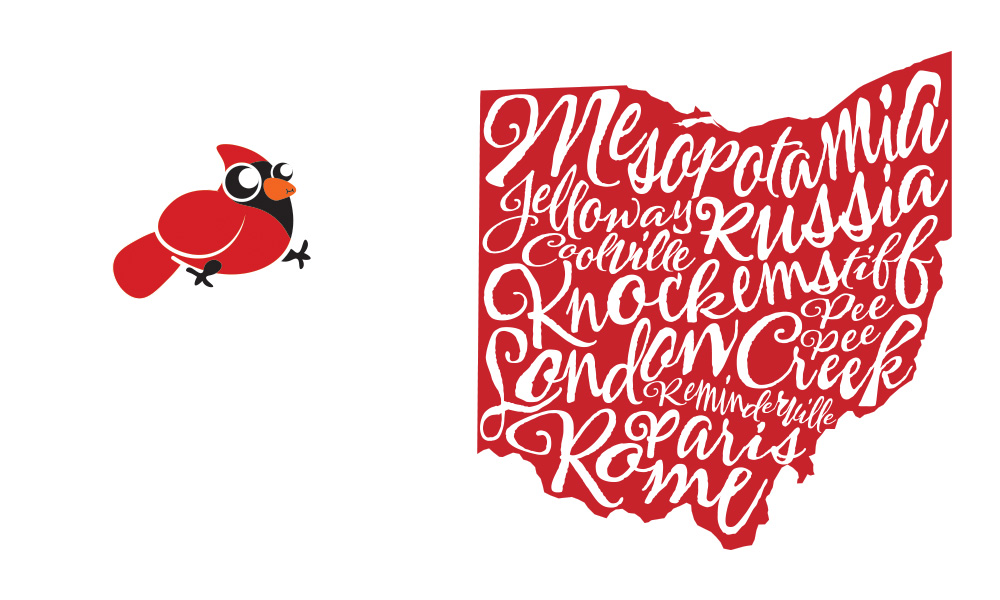An Ohio map reads like an autobiography. The names pinned to places — the towns, counties, watercourses, and junctures that you may have never even heard of — tell stories of experience, chance encounters, longings for a better future, or the wistful wishing for a place left behind. Some pay tribute to heroes of the past. Others are curious and comical, leaving one to wonder, “Uh, what were they thinking?”
The gouging push and soggy pull of glaciers and the long steady movement of water shaped the land we see today, and strongly influenced names given the sinuous blue-line waters draining north to Lake Erie or south toward the Ohio River.
Then there’s the spilling of blood — the clash of cultures and struggle to possess what Native Americans, the British, and a fledgling United States of America all wanted to call their own.
Let’s consider the latter first.
Four Mile Creek, for example, rises in the uplands along the Indiana-Ohio state line, picking up the waters of small rills and runs and seeps. It bumps into glacial moraines and purls through pastoral farmsteads on its downhill destiny with the Great Miami River — by which time it has become a substantial stream. Its placid form and lyrical name belie the fact it was born from warfare.
In October 1791, the entirety of the U.S. Army set out from a freshly built Fort Hamilton (named to honor Secretary of the Treasury Alexander Hamilton) and nested on a bench of land above the Great Miami River. The autumn foray would become a march to massacre. The soldiers, in a slow slog north, cut a road in a wide swath through virgin forest. Four miles from the fort’s gate, the army camped for a night along a stream. The next day, three miles on, they crossed Seven Mile Creek. A month later, on the headwaters of the Wabash River, they met a confederation of Indian tribes and suffered a crushing defeat. 
It became known as St. Clair’s Defeat. The battle site where upwards of 800 soldiers exhaled their last is today’s Fort Recovery. Those vanquished under the command of the Miami leader, Little Turtle, or the Shawnee leader, Blue Jacket — such as Arthur St. Clair, Richard Butler, and William Darke — live on in stream, county, and township names.
Of course, Native American place names also persist in Ohio. The difference is that they tend to be descriptive, rather than tributes to people or commemorative of experiences. “Miami,” of course, lives large in Ohio. According to linguist David Costa of the Myaamia Project at Miami University in Oxford, the Great and Little Miami river names include an adopted English use of the original Myaamia, meaning “downstream person.”
According to Costa, Miami Indians knew the Great Miami River as ahseni siipiiwi, literally “Rock River.” Lake Erie was known as ciinkwihtanwi kihcikami, literally “sea of the falls,” referring to Niagara Falls downstream. St. Mary’s River on the Indiana-Ohio state line was nameewa siipiiwi, literally “sturgeon river.”
You won’t find any of those on a map, though you will find numerous Anglicized versions of Algonquin and Iroquois words — Coshocton, for example, comes from the Lenape/Delaware word goschachgunk, which simply signified a river crossing.
Ohio has a fair number of communities with stilted names that speak to high aims of its early settlers. Akron derives from Greek for “high place.” Gallipolis evokes a sense of the Greek city-state self-governance. Xenia reflects the hospitality expected in the home in classical Greece.
Alert Station is a curious hamlet near Ross (formerly Venice, corrupted from Venus), northwest of Cincinnati (so-named after the Roman soldier-farmer Cincinnatus). Alert was and remains a crossroads. But those pioneer settlers valued literature and ensured early on they had a library populated with the classics, and the folks there were considered “alert,” as in “intellectual.”
Ohio had no shortage of volunteers answering President Polk’s call to action against Mexico in 1846. A good many Ohioans served in the Mexican War, and the effect of their return in 1848 was certainly felt in new place names. The soldiers may have desired to memorialize those killed in action, or they romanticized the places and people they had met in what is now New Mexico, California, and interior Mexico. Most prominent is Rio Grande, Ohio, pronounced “RYE-O Grand.” And there are the Buckeye burgs of Vera Cruz, Monterey, and Montezuma, as well as the City of Holy Faith: Santa Fe, Ohio.
One cannot consider the topic of Ohio’s place names without addressing those that leave you scratching your head. Ever heard of No Name, Knockemstiff, or Pee Pee Creek? All three exist in southern Ohio, and it’s the origin of the last that’s well-documented. Pee Pee Creek trickles through Pebble Township in Pike County, which had been named by Peter Patrick — who had carved his initials in a stream-side tree circa 1785.
Ohio’s place names run the spectrum from commonplace to implausible. One can go to Russia, visit Rome, London and Paris, and take a drive through Mesopotamia — without ever leaving the state. Every place name relates to desires, experience and perception. And what they have in common across that spectrum is enchantment in the spirit of their origins.









